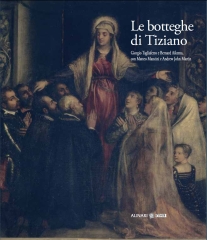The shops of Titian
 Traditionally, the history of art is assumed that the great painters of the past have produced their masterpieces in a kind of splendid isolation. Only recently, specialists have realized that things were not that way at all, but that the artists were in charge of shops more or less extended. Their works, in much, are the result of a collective work, not a single solitary genius. Strangely, the vast corpus of works by Titian has never been examined in a systematic way from this point of view. Titian's turns out to be one of the first "factories images", operating at levels not only local and regional, but also European: a laboratory that, in nearly three quarters of a century of activity, has been able to achieve a staggering amount of paintings of various types and category, thus marking deeply the course of Italian and European. Rather than "Titian" would agree to speak of a "system Titian", a flexible workforce, pragmatic, adaptable to the needs that had appeared from time to time in different form. Here is delineated by the huge issue addressed in the book with substantial new data and method. The book offers, in fact, a number of different tracks to navigate the immense catalog of Titian, moving along one chronological development that is in the second sojourn in Augusta, a fundamental and crucial juncture in the reorganization of the production system. The number and types of paintings by Titian and workshop are monitored in two distinct phases, located before and after trips to Germany and labeled with different needs and functions. The last section clarifies how the workshop, between the end of the sixteenth and the early seventeenth century, has gone progressively crystallizing that "Titian model" that would prove essential to the new conception of painting handed down by great European masters. The book bears the signature of four scholars who, the past three years, have collaborated on a collective enterprise based on a unique concept, as evidenced by the volume of the organic structure and tripartite.
Traditionally, the history of art is assumed that the great painters of the past have produced their masterpieces in a kind of splendid isolation. Only recently, specialists have realized that things were not that way at all, but that the artists were in charge of shops more or less extended. Their works, in much, are the result of a collective work, not a single solitary genius. Strangely, the vast corpus of works by Titian has never been examined in a systematic way from this point of view. Titian's turns out to be one of the first "factories images", operating at levels not only local and regional, but also European: a laboratory that, in nearly three quarters of a century of activity, has been able to achieve a staggering amount of paintings of various types and category, thus marking deeply the course of Italian and European. Rather than "Titian" would agree to speak of a "system Titian", a flexible workforce, pragmatic, adaptable to the needs that had appeared from time to time in different form. Here is delineated by the huge issue addressed in the book with substantial new data and method. The book offers, in fact, a number of different tracks to navigate the immense catalog of Titian, moving along one chronological development that is in the second sojourn in Augusta, a fundamental and crucial juncture in the reorganization of the production system. The number and types of paintings by Titian and workshop are monitored in two distinct phases, located before and after trips to Germany and labeled with different needs and functions. The last section clarifies how the workshop, between the end of the sixteenth and the early seventeenth century, has gone progressively crystallizing that "Titian model" that would prove essential to the new conception of painting handed down by great European masters. The book bears the signature of four scholars who, the past three years, have collaborated on a collective enterprise based on a unique concept, as evidenced by the volume of the organic structure and tripartite.
In collaboration with the Fondazione Centro Studi di Cadore and Titian
Texts: Giorgio Tagliaferro, Bernard Aikema, Matthew Mancini, Andrew John Martin
Format: cm 24×28pp.. 504
Photos: 270Hardcover
ISBN: 978-88-6302-017-5

 Italiano
Italiano English
English Français
Français Deutsch
Deutsch Español
Español